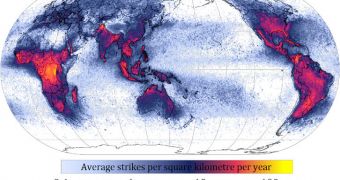A few years ago, atmospheric scientists discovered an peculiar phenomenon taking place as lightning strikes were headed to Earth – the generation of a flash of radiation accompanying the event. Now, the cause of these flashes is beginning to be revealed.
Called gamma-ray flashes (GRF), these phenomena are characterized by a short discharge of highly-energetic particles towards space (in the opposite direction the lightning strikes). The flash originates in the same area as the lightning does.
Therefore, when viewed from Earth's orbit for example, a thunderstorm is seen producing numerous streaks of lightning, which are accompanied by a few GRF. The latter are easily observable from satellites, or by astronauts living on the International Space Station (ISS).
Considering that gamma-rays are the most energetic form of radiation ever discovered, experts were very curious to learn precisely what was causing them to be produced by a simple rain cloud.
Though GRF usually last for less than a millisecond, experts have recently collected enough data about them to determine what properties lightning needs to have in order to produce the powerful radiation.
The gamma-ray flash studies were carried out by listening to the powerful radio wave bursts they emit when they are generated. In addition, several types of lightning (air-to-ground, air-to-air) were studied.
Experts say that, as lightning leaves its point of origin – and heads either to the ground or to an inferior level of the same clouds – it leaves behind a trail of low resistance. When the return stroke develops, it travels upwards on the same path.
But this time it meets less resistance, which means that a much greater current can be carried upwards, scientists say. This was established during a study conducted between 2004 and 2009, Space reports.
During this interval, experts managed to image about 56 GRF, by using the Reuven Ramaty High Energy Solar Spectroscopic Imager (RHESSI) satellite. The gamma-ray readings were correlated to the radio signals that were released at the same time.
“Terrestrial gamma-ray flashes are produced by what seems in many ways like very ordinary and common lightning. But that they also seem rare according to gamma-ray detection is part of the puzzle of terrestrial gamma-ray flashes,” explains Steven Cummer.
The expert, who was a researcher on the new study, holds an appointment as an electrical engineer at the Duke University. Details of the new study appear in the March 16 online issue of the esteemed Journal of Geophysical Research-Space Physics.
“Now that we've identified an important terrestrial gamma-ray flash-associated process, we can begin to use our radio measurements of lightning to find out how common it is,” Cummer explains further.
“Now that we have what appears to be a fairly reliable signature of a terrestrial gamma-ray flash that can be found from ground-based lightning measurements alone, we can dramatically expand the number and detail of events we can look at,” he concludes.

 14 DAY TRIAL //
14 DAY TRIAL //